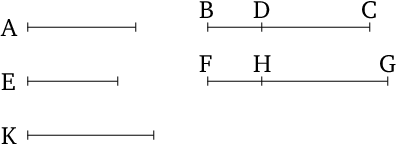Proposition: Prop. 10.087: Construction of Third Apotome
(Proposition 87 from Book 10 of Euclid's “Elements”)
To find a third apotome.
- Let the rational (straight line) $A$ be laid down.
- And let the three numbers, $E$, $BC$, and $CD$, not having to one another the ratio which (some) square number (has) to (some) square number, be laid down.
- And let $CB$ have to $BD$ the ratio which (some) square number (has) to (some) square number.
- And let it have been contrived that as $E$ (is) to $BC$, so the square on $A$ (is) to the square on $FG$, and as $BC$ (is) to $CD$, so the square on $FG$ (is) to the (square) on $GH$ [Prop. 10.6 corr.] .
- Therefore, since as $E$ is to $BC$, so the square on $A$ (is) to the square on $FG$, the square on $A$ is thus commensurable with the square on $FG$ [Prop. 10.6].
- And the square on $A$ (is) rational.
- Thus, the (square) on $FG$ (is) also rational.
- Thus, $FG$ is a rational (straight line).
- And since $E$ does not have to $BC$ the ratio which (some) square number (has) to (some) square number, the square on $A$ thus does not have to the [square] on $FG$ the ratio which (some) square number (has) to (some) square number either.
- Thus, $A$ is incommensurable in length with $FG$ [Prop. 10.9].
- Again, since as $BC$ is to $CD$, so the square on $FG$ is to the (square) on $GH$, the square on $FG$ is thus commensurable with the (square) on on $GH$ [Prop. 10.6].
- And the (square) on $FG$ (is) rational.
- Thus, the (square) on $GH$ (is) also rational.
- Thus, $GH$ is a rational (straight line).
- And since $BC$ does not have to $CD$ the ratio which (some) square number (has) to (some) square number, the (square) on $FG$ thus does not have to the (square) on $GH$ the ratio which (some) square number (has) to (some) square number either.
- Thus, $FG$ is incommensurable in length with $GH$ [Prop. 10.9].
- And both are rational (straight lines).
- $FG$ and $GH$ are thus rational (straight lines which are) commensurable in square only.
- Thus, $FH$ is an apotome [Prop. 10.73].
- So, I say that (it is) also a third (apotome) .

Modern Formulation
This proposition proves that the third apotome has length
\[\sqrt{\alpha}\,\left(1-\sqrt{1-\beta^{\,2}}\right),\]
where \(\alpha,\beta\) denote positive rational numbers.
Notes
See also [Prop. 10.50].
Table of Contents
Proofs: 1
Mentioned in:
Propositions: 1
Thank you to the contributors under CC BY-SA 4.0! 

- Github:
-

- non-Github:
- @Fitzpatrick
References
Adapted from (subject to copyright, with kind permission)
- Fitzpatrick, Richard: Euclid's "Elements of Geometry"
Adapted from CC BY-SA 3.0 Sources:
- Prime.mover and others: "Pr∞fWiki", https://proofwiki.org/wiki/Main_Page, 2016
